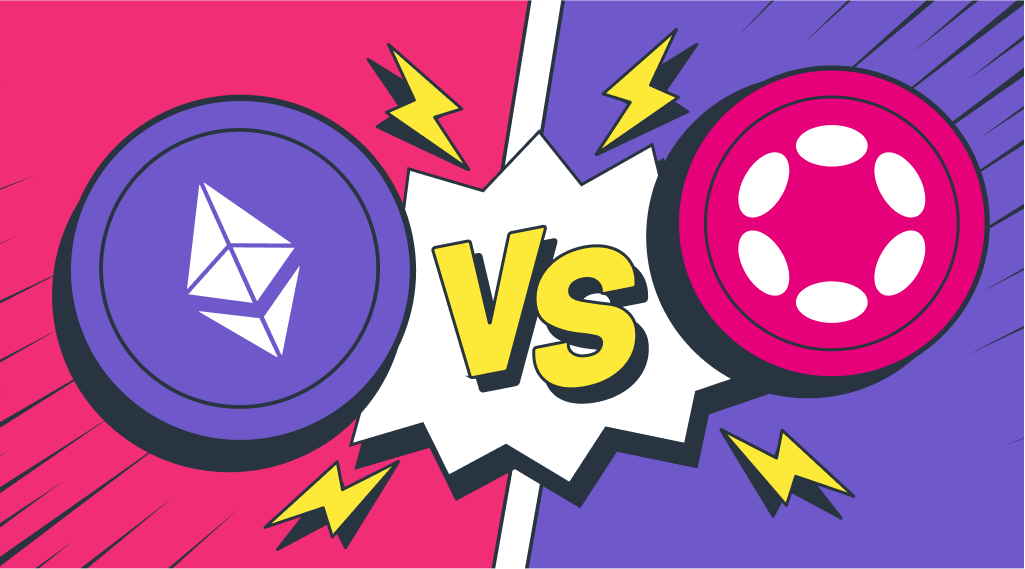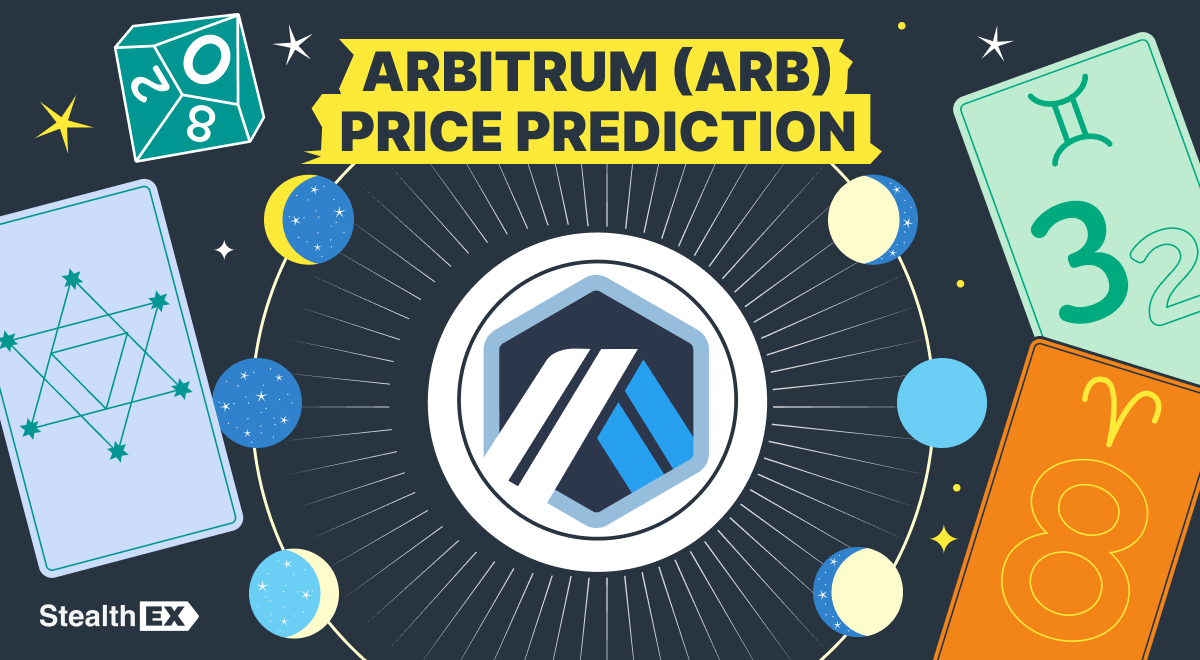Polkadot vs Ethereum — Which Is Better? DOT and ETH

Polkadot vs Ethereum: DOT and ETH are two leading names in the blockchain universe. Although they have distinct foundations and visions, comparisons between them are inevitable. This article aims to highlight the primary distinctions and similarities between Polkadot and Ethereum. Dive in with us as we navigate the nuances of these two groundbreaking platforms and uncover what truly differentiates them.

Article contents
- 1 What Is Ethereum (ETH)?
- 2 What Is Polkadot (DOT)?
- 3 Polkadot vs Ethereum – Key Differences Between DOT and ETH
- 4 Polkadot vs Ethereum – Key Similarities Between DOT and ETH
- 5 Summary
- 6 FAQ – Frequently Asked Question
- 6.1 What Are Polkadot and Ethereum?
- 6.2 Who Founded Polkadot and Ethereum?
- 6.3 How Do the Consensus Mechanisms of Polkadot and Ethereum Differ?
- 6.4 Do Both Platforms Support Smart Contracts?
- 6.5 Which Platform Is Older, Polkadot or Ethereum?
- 6.6 Are Both Polkadot and Ethereum Open-Source Platforms?
- 6.7 DOT vs ETH – Which One Is Better Investment?
What Is Ethereum (ETH)?
Ethereum (ETH), often referred to as the “world computer,” is a decentralized platform that enables developers to build and deploy smart contracts and decentralized applications (DApps). Unlike other cryptocurrencies that serve primarily as a medium of exchange, Ethereum’s primary innovation is its ability to execute complex contractual agreements without intermediaries.
Ethereum was proposed in late 2013 by a programmer named Vitalik Buterin. Disturbed by the limitations of Bitcoin, Buterin aimed to create a platform that went beyond the financial use cases allowed by Bitcoin. The Ethereum white paper was released, detailing the technical design and rationale for the Ethereum protocol and smart contracts architecture. In 2014, development was crowdfunded, and the network officially went live on July 30, 2015.
At the heart of Ethereum is the Ethereum Virtual Machine (EVM), which can execute code of arbitrary algorithmic complexity. In simpler terms, it allows for the creation of applications that can run exactly as programmed without any possibility of downtime, censorship, fraud, or third-party interference.
Ether (ETH) is the native cryptocurrency of the Ethereum platform. It’s not just a digital currency. It’s used to compensate participants who perform computations and validate transactions.
What Is Polkadot (DOT)?
Polkadot (DOT) is a groundbreaking multi-chain platform designed to enable various blockchains to interoperate and share information seamlessly. It aims to solve the challenges of scalability, governance, and interoperability that have been persistent in the blockchain ecosystem.
Polkadot was conceptualized by Dr. Gavin Wood, one of the co-founders of Ethereum and the individual responsible for creating its technical specification, the Ethereum Yellow Paper. Recognizing the limitations and challenges of single-chain architectures, Dr. Wood proposed Polkadot in 2016. The project was then developed by Web3 Foundation and Parity Technologies, and its mainnet was launched in May 2020.
Polkadot’s unique architecture consists of a central relay chain and multiple parachains (parallel chains). Here’s a breakdown:
- Relay Chain: The heart of Polkadot, responsible for the network’s security, consensus, and cross-chain interoperability.
- Parachains: Independent blockchains that run in parallel, benefiting from the security and interoperability provided by the relay chain.
- Bridges: Special links that allow Polkadot to communicate with external blockchains like Ethereum or Bitcoin.
The platform uses a novel consensus mechanism called Nominated Proof-of-Stake (NPoS) and introduces the concept of “governance as a service,” where changes to the network are proposed and voted on by DOT token holders.
DOT is Polkadot’s native cryptocurrency. It serves three primary purposes: governance over the network, staking to secure the relay chain, and bonding to add new parachains.
Polkadot vs Ethereum – Key Differences Between DOT and ETH
Both Polkadot and Ethereum have garnered significant attention for their unique features and visions for the decentralized web. However, they are fundamentally different in many ways. Let’s explore the key differences between Polkadot’s DOT and Ethereum’s ETH.
- Origins and Founders – Ethereum was proposed in late 2013 by programmer Vitalik Buterin. It went live in 2015 and has since become the second-largest cryptocurrency by market capitalization. Ethereum’s primary goal was to be a platform for decentralized applications (DApps) and smart contracts. On the other hand, Polkadot was created by Dr. Gavin Wood, one of the co-founders of Ethereum and the inventor of the Solidity programming language. Launched in 2020, Polkadot aims to enable different blockchains to transfer messages and value in a trust-free fashion, seeking to make a web where independent blockchains can interoperate.
- Consensus Mechanisms – Originally, Ethereum operated on a proof-of-work (PoW) consensus mechanism, similar to Bitcoin. However, it transitioned to Ethereum 2.0, which operate on a proof-of-stake (PoS) mechanism. Polkadot uses a hybrid consensus model combining aspects of PoS and nominated proof-of-stake (NPoS). This allows for scalability and ensures that the network remains secure.
- Interoperability – Ethereum primarily focuses on its own ecosystem. While it does support tokens through the ERC-20 and ERC-721 standards, it doesn’t natively support interoperability with other blockchains. On other hand, Interoperability is one of Polkadot’s core features. It allows different blockchains to communicate and share information, making it possible for a variety of networks to work together seamlessly.
- Scalability – Ethereum has faced scalability issues in the past. The upcoming shard chains, aims to address these concerns and increase the number of transactions the network can handle. Polkadot uses parachains (parallel chains) to achieve scalability. Each parachain can process transactions and act independently, allowing for multiple transactions across different chains simultaneously.
- Development Environment – Developers primarily use Solidity to write smart contracts on Ethereum. Polkadot offers more flexibility in this regard. Developers can use multiple languages, and the platform supports various frameworks, making it easier to create applications.
- Governance – Ethereum has faced challenges regarding on-chain governance, with most decisions made off-chain by developers and stakeholders. Polkadot has a built-in on-chain governance mechanism, allowing DOT holders to have a say in the development and changes to the network.
- Token Utility – ETH is used to compensate participants who perform computations and validate transactions. Since Merge and Ethereum 2.0, it’s also used for staking. DOT has multiple utilities, including governance, staking, and bonding.
While both Polkadot and Ethereum have their strengths and weaknesses, they serve different purposes in the blockchain ecosystem. Ethereum’s focus on decentralized applications and smart contracts has made it a favorite among developers. At the same time, Polkadot’s emphasis on interoperability and scalability positions it as a key player in the future of interconnected blockchains.
Choose StealthEX for Exchange and Buy Crypto
- User-Friendly — Simple and minimalistic interface for everyone.
- Fast and Private — Instant non-custodial cryptocurrency exchanges.
- Buy crypto with Credit Card.
- 1400+ coins and tokens are available for limitless, quick and easy exchanges.
- NO-KYC crypto exchanges — Buy cryptocurrency up to €700 without KYC!
- StealthEX crypto exchange app — Process crypto swaps at the best rates wherever you are.
- 24/7 Customer Support.
Earn from Each Exchange by Joining StealthEX Affiliate Program.
Become a partner right now and use affiliate tools:
- Public API — Earn from your wallet, aggregator, or exchange terminal.
- Referral Links — Recommend StealthEX to your audience.
- Exchange Widget — Built crypto exchange widget on any page of your website.
- Button — A perfect choice for traffic monetization.
- Banner — Track conversion and stats right in the personal cabinet.
Polkadot vs Ethereum – Key Similarities Between DOT and ETH
Polkadot and Ethereum, while distinct in their visions and technical implementations, share several foundational similarities. Both platforms have been instrumental in advancing the blockchain and cryptocurrency space. Let’s check key similarities between Polkadot’s DOT and Ethereum’s ETH.
- Foundational Goal – Both Polkadot and Ethereum aim to create a decentralized web. While their methods and focuses might differ, the overarching goal is to reduce centralization and promote a more open, transparent digital ecosystem.
- Smart Contracts – Both platforms support the development and deployment of smart contracts.
- Decentralization – Both Ethereum and Polkadot prioritize decentralization, ensuring that no single entity has complete control over the network. This decentralization enhances security, transparency, and resistance to censorship.
- Active Development Communities – Both platforms boast robust and active development communities. This ensures continuous improvements, innovations, and a wealth of resources for developers and users alike.
- Staking Mechanism – Both Ethereum and Polkadot utilize a proof-of-stake (PoS) consensus mechanism, allowing holders to “stake” their tokens to support network operations and security in return for rewards.
- Token Utility – Both ETH and DOT tokens are not just for trading. They play integral roles in their respective ecosystems, from staking and governance to paying for transaction fees.
- Open Source – Both Polkadot and Ethereum are open-source platforms. This means that their codebases are publicly accessible, promoting transparency and allowing developers from around the world to contribute.
- Focus on Interoperability – While Polkadot has a primary focus on interoperability, Ethereum is not far behind. With the advent of bridges and other cross-chain solutions, Ethereum is also moving towards a more interconnected blockchain ecosystem.
So let’s summarize the differences and similarities between Polkadot (DOT) and Ethereum (ETH) in table form:
| Aspect | Polkadot (DOT) | Ethereum (ETH) |
| Origins | Created by Dr. Gavin Wood, co-founder of Ethereum. | Proposed by Vitalik Buterin and launched in 2015. |
| Consensus | Hybrid model combining PoS and NPoS. | Proof-of-Stake (PoS) |
| Interoperability | Core feature, enabling different blockchains to communicate. | Primarily focuses on its own ecosystem but moving towards more interoperability with bridges. |
| Scalability | Uses parachains for scalability. | Working on shard chains for scalability. |
| Development | Supports multiple languages and frameworks. | Primarily uses Solidity for smart contracts. |
| Governance | Built-in on-chain governance mechanism. | Decisions are mostly made off-chain by developers and stakeholders. |
| Token Utility | Used for governance, staking, and bonding. | Used for computations, validating transactions, and staking. |
| Goal | Interconnected blockchains and a decentralized web. | Platform for decentralized applications (DApps) and smart contracts. |
| Smart Contracts | Supported. | Supported. |
| Decentralization | Prioritized, with no single entity having control. | Prioritized, with a focus on reducing centralization. |
| Community | Active development community. | Robust and very active development community. |
| Open Source | Yes. | Yes. |
Summary
While both Polkadot and Ethereum aim to foster a decentralized web, they have distinct visions and technical implementations. Ethereum primarily focuses on decentralized applications and smart contracts. Polkadot, on the other hand, emphasizes interoperability between blockchains.
Both platforms support smart contracts and prioritize decentralization, with active development communities backing them. However, their consensus mechanisms, scalability solutions, and governance structures differ. Despite these differences, both platforms play pivotal roles in shaping the future of the decentralized crypto sector.
FAQ – Frequently Asked Question
What Are Polkadot and Ethereum?
Polkadot and Ethereum are both blockchain platforms. While Ethereum primarily focuses on decentralized applications and smart contracts, Polkadot emphasizes enabling different blockchains to communicate and share information.
Who Founded Polkadot and Ethereum?
Ethereum was proposed by Vitalik Buterin and launched in 2015. Polkadot was created by Dr. Gavin Wood, a co-founder of Ethereum.
How Do the Consensus Mechanisms of Polkadot and Ethereum Differ?
Ethereum originally operated on a proof-of-work (PoW) mechanism but transitioned to proof-of-stake (PoS). Polkadot uses a hybrid model combining PoS and nominated proof-of-stake (NPoS).
Do Both Platforms Support Smart Contracts?
Yes, both Polkadot and Ethereum support the development and deployment of smart contracts.
Which Platform Is Older, Polkadot or Ethereum?
Ethereum was launched in 2015, making it older than Polkadot, which was launched in 2020.
Are Both Polkadot and Ethereum Open-Source Platforms?
Yes, both platforms are open-source, promoting transparency and allowing global developer contributions.
DOT vs ETH – Which One Is Better Investment?
Both Polkadot (DOT) and Ethereum (ETH) have their unique features, visions, and potential growth trajectories, making them attractive to different types of investors.
Follow us on Medium, Twitter, Telegram, YouTube, and Publish0x to stay updated about the latest news on StealthEX.io and the rest of the crypto world.
This article is not supposed to provide financial advice. Digital assets are risky. Be sure to do your own research and consult your financial advisor before investing.
cryptocurrency DOT ETH Ethereum PolkadotRecent Articles on Cryptocurrency
 Crypto News: Trump Media Approved, Cardano's Bitcoin Bridge, XRP's Ethereum Plans
Crypto News: Trump Media Approved, Cardano's Bitcoin Bridge, XRP's Ethereum Plans  Arbitrum Price Prediction: Is ARB Crypto a Good Investment?
Arbitrum Price Prediction: Is ARB Crypto a Good Investment? 